PALIPERIDONE
These highlights do not include all the information needed to use PALIPERIDONE EXTENDED-RELEASE TABLETS safely and effectively. See full prescribing information for PALIPERIDONE EXTENDED-RELEASE TABLETS. PALIPERIDONE extended-release tablets, for oral use Initial U.S. Approval: 2006
39bb8094-6931-4909-a061-b8a79de17aee
HUMAN PRESCRIPTION DRUG LABEL
Aug 23, 2023
Ascent Pharmaceuticals, Inc.
DUNS: 080938961
Products 4
Detailed information about drug products covered under this FDA approval, including NDC codes, dosage forms, ingredients, and administration routes.
paliperidone
Product Details
FDA regulatory identification and product classification information
FDA Identifiers
Product Classification
Product Specifications
INGREDIENTS (18)
paliperidone
Product Details
FDA regulatory identification and product classification information
FDA Identifiers
Product Classification
Product Specifications
INGREDIENTS (18)
paliperidone
Product Details
FDA regulatory identification and product classification information
FDA Identifiers
Product Classification
Product Specifications
INGREDIENTS (17)
paliperidone
Product Details
FDA regulatory identification and product classification information
FDA Identifiers
Product Classification
Product Specifications
INGREDIENTS (18)
Drug Labeling Information
INDICATIONS & USAGE SECTION
1 INDICATIONS AND USAGE
1.1 Schizophrenia
Paliperidone extended-release tablets are indicated for the treatment of schizophrenia [see Clinical Studies (14.1)].
The efficacy of paliperidone in schizophrenia was established in three 6-week trials in adults and one 6-week trial in adolescents, as well as one maintenance trial in adults.
1.2 Schizoaffective Disorder
Paliperidone extended-release tablets are indicated for the treatment of schizoaffective disorder as monotherapy and an adjunct to mood stabilizers and/or antidepressant therapy [see Clinical Studies (14.2)].
The efficacy of paliperidone in schizoaffective disorder was established in two 6-week trials in adults.
Paliperidone extended-release tablets are an atypical antipsychotic agent indicated for (1)
Treatment of schizophrenia (1.1) (1)
- Adults: Efficacy was established in three 6-week trials and one maintenance trial. (14.1)
- Adolescents (ages 12-17): Efficacy was established in one 6-week trial. (14.1)
Treatment of schizoaffective disorder as monotherapy and as an adjunct to mood stabilizers and/or antidepressants. (1.2) (1)
- Efficacy was established in two 6-week trials in adult patients. (14.2)
WARNINGS AND PRECAUTIONS SECTION
5 WARNINGS AND PRECAUTIONS
5.1 Increased Mortality in Elderly Patients with Dementia-Related Psychosis
Elderly patients with dementia-related psychosis treated with antipsychotic drugs are at an increased risk of death. Analyses of 17 placebo-controlled trials (modal duration of 10 weeks), largely in patients taking atypical antipsychotic drugs, revealed a risk of death in drug-treated patients of between 1.6 to 1.7 times the risk of death in placebo-treated patients. Over the course of a typical 10-week controlled trial, the rate of death in drug- treated patients was about 4.5%, compared to a rate of about 2.6% in the placebo group. Although the causes of death were varied, most of the deaths appeared to be either cardiovascular (e.g., heart failure, sudden death) or infectious (e.g., pneumonia) in nature. Observational studies suggest that, similar to atypical antipsychotic drugs, treatment with conventional antipsychotic drugs may increase mortality. The extent to which the findings of increased mortality in observational studies may be attributed to the antipsychotic drug as opposed to some characteristic(s) of the patients is not clear. Paliperidone is not approved for the treatment of dementia-related psychosis [see Boxed Warning].
5.2 Cerebrovascular Adverse Reactions, Including Stroke, in Elderly
Patients with Dementia-Related Psychosis
In placebo-controlled trials with risperidone, aripiprazole, and olanzapine in elderly subjects with dementia, there was a higher incidence of cerebrovascular adverse reactions (cerebrovascular accidents and transient ischemic attacks) including fatalities compared to placebo-treated subjects. Paliperidone was not marketed at the time these studies were performed. Paliperidone is not approved for the treatment of patients with dementia- related psychosis [see also Boxed Warning and Warnings and Precautions (5.1)].
5.3 Neuroleptic Malignant Syndrome
Neuroleptic Malignant Syndrome (NMS), a potentially fatal symptom complex, has been reported in association with antipsychotic drugs, including paliperidone. Clinical manifestations of NMS are hyperpyrexia, muscle rigidity, altered mental status including delirium, and autonomic instability (irregular pulse or blood pressure, tachycardia, diaphoresis, and cardiac dysrhythmia). Additional signs may include elevated creatine phosphokinase, myoglobinuria, rhabdomyolysis, and acute renal failure.
If NMS is suspected, immediately discontinue paliperidone and provide symptomatic treatment and monitoring.
5.4 QT Prolongation
Paliperidone causes a modest increase in the corrected QT (QTc) interval. The use of paliperidone should be avoided in combination with other drugs that are known to prolong QTc including Class 1A (e.g., quinidine, procainamide) or Class III (e.g., amiodarone, sotalol) antiarrhythmic medications, antipsychotic medications (e.g., chlorpromazine, thioridazine), antibiotics (e.g., gatifloxacin, moxifloxacin), or any other class of medications known to prolong the QTc interval. Paliperidone should also be avoided in patients with congenital long QT syndrome and in patients with a history of cardiac arrhythmias.
Certain circumstances may increase the risk of the occurrence of torsade de pointes and/or sudden death in association with the use of drugs that prolong the QTc interval, including (1) bradycardia; (2) hypokalemia or hypomagnesemia; (3) concomitant use of other drugs that prolong the QTc interval; and (4) presence of congenital prolongation of the QT interval.
The effects of paliperidone on the QT interval were evaluated in a double- blind, active-controlled (moxifloxacin 400 mg single dose), multicenter QT study in adults with schizophrenia and schizoaffective disorder, and in three placebo- and active-controlled 6-week, fixed-dose efficacy trials in adults with schizophrenia.
In the QT study (n=141), the 8 mg dose of immediate-release oral paliperidone (n=50) showed a mean placebo-subtracted increase from baseline in QTcLD of 12.3 msec (90% CI: 8.9; 15.6) on day 8 at 1.5 hours post-dose. The mean steady-state peak plasma concentration for this 8 mg dose of paliperidone immediate-release was more than twice the exposure observed with the maximum recommended 12 mg dose of paliperidone (Cmax ss = 113 ng/mL and 45 ng/mL, respectively, when administered with a standard breakfast). In this same study, a 4 mg dose of the immediate-release oral formulation of paliperidone, for which Cmax ss = 35 ng/mL, showed an increased placebo-subtracted QTcLD of 6.8 msec (90% CI: 3.6; 10.1) on day 2 at 1.5 hours post-dose. None of the subjects had a change exceeding 60 msec or a QTcLD exceeding 500 msec at any time during this study.
For the three fixed-dose efficacy studies in subjects with schizophrenia, electrocardiogram (ECG) measurements taken at various time points showed only one subject in the paliperidone 12 mg group had a change exceeding 60 msec at one time-point on Day 6 (increase of 62 msec). No subject receiving paliperidone had a QTcLD exceeding 500 msec at any time in any of these three studies.
5.5 Tardive Dyskinesia
Tardive dyskinesia, a syndrome consisting of potentially irreversible, involuntary, dyskinetic movements, may develop in patients treated with antipsychotic drugs. Although the prevalence of the syndrome appears to be highest among the elderly, especially elderly women, it is impossible to predict which patients will develop the syndrome. Whether antipsychotic drug products differ in their potential to cause tardive dyskinesia is unknown.
The risk of developing tardive dyskinesia and the likelihood that it will become irreversible appear to increase with duration of treatment and the cumulative dose. The syndrome can develop after relatively brief treatment periods, even at low doses. It may also occur after discontinuation of treatment.
Tardive dyskinesia may remit, partially or completely, if antipsychotic treatment is withdrawn. Antipsychotic treatment, itself, however, may suppress (or partially suppress) the signs and symptoms of the syndrome and thereby may possibly mask the underlying process. The effect that symptomatic suppression has upon the long-term course of the syndrome is unknown.
Given these considerations, paliperidone should be prescribed in a manner that is most likely to minimize the occurrence of tardive dyskinesia. Chronic antipsychotic treatment should generally be reserved for patients: (1) who suffer from a chronic illness that is known to respond to antipsychotic drugs, and (2) for whom alternative, equally effective, but potentially less harmful treatments are not available or appropriate. In patients who do require chronic treatment, use the lowest dose and the shortest duration of treatment producing a satisfactory clinical response. Periodically reassess the need for continued treatment.
If signs and symptoms of tardive dyskinesia appear in a patient on paliperidone, drug discontinuation should be considered. However, some patients may require treatment with paliperidone despite the presence of the syndrome.
5.6 Metabolic Changes
Atypical antipsychotic drugs have been associated with metabolic changes that may increase cardiovascular/cerebrovascular risk. These metabolic changes include hyperglycemia, dyslipidemia, and body weight gain. While all of the drugs in the class have been shown to produce some metabolic changes, each drug has its own specific risk profile.
Hyperglycemia and Diabetes Mellitus
Hyperglycemia and diabetes mellitus, in some cases extreme and associated with ketoacidosis or hyperosmolar coma or death, have been reported in patients treated with all atypical antipsychotics. These cases were, for the most part, seen in post-marketing clinical use and epidemiologic studies, not in clinical trials, and there have been few reports of hyperglycemia or diabetes in trial subjects treated with paliperidone. Assessment of the relationship between atypical antipsychotic use and glucose abnormalities is complicated by the possibility of an increased background risk of diabetes mellitus in patients with schizophrenia and the increasing incidence of diabetes mellitus in the general population. Given these confounders, the relationship between atypical antipsychotic use and hyperglycemia-related adverse events is not completely understood. However, epidemiological studies suggest an increased risk of treatment-emergent hyperglycemia-related adverse events in patients treated with the atypical antipsychotics. Because paliperidone was not marketed at the time these studies were performed, it is not known if paliperidone is associated with this increased risk.
Patients with an established diagnosis of diabetes mellitus who are started on atypical antipsychotics should be monitored regularly for worsening of glucose control. Patients with risk factors for diabetes mellitus (e.g., obesity, family history of diabetes) who are starting treatment with atypical antipsychotics should undergo fasting blood glucose testing at the beginning of treatment and periodically during treatment. Any patient treated with atypical antipsychotics should be monitored for symptoms of hyperglycemia including polydipsia, polyuria, polyphagia, and weakness. Patients who develop symptoms of hyperglycemia during treatment with atypical antipsychotics should undergo fasting blood glucose testing. In some cases, hyperglycemia has resolved when the atypical antipsychotic was discontinued; however, some patients required continuation of anti-diabetic treatment despite discontinuation of the suspect drug.
Pooled data from the three placebo-controlled, 6-week, fixed-dose studies in adult subjects with schizophrenia are presented in Table 1a.
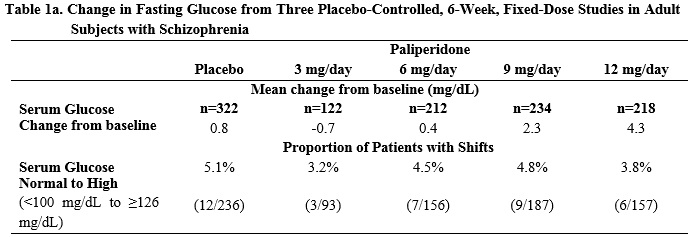
In the uncontrolled, longer-term open-label extension studies, paliperidone was associated with a mean change in glucose of +3.3 mg/dL at Week 24 (n=570) and +4.6 mg/dL at Week 52 (n=314).
Data from the placebo-controlled 6-week study in adolescent subjects (12-17 years of age) with schizophrenia are presented in Table 1b.
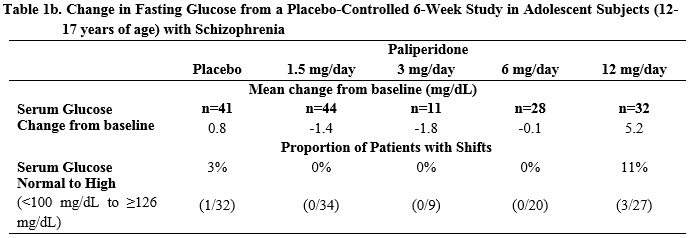
Dyslipidemia
Undesirable alterations in lipids have been observed in patients treated with atypical antipsychotics.
Pooled data from the three placebo-controlled, 6-week, fixed-dose studies in adult subjects with schizophrenia are presented in Table 2a.
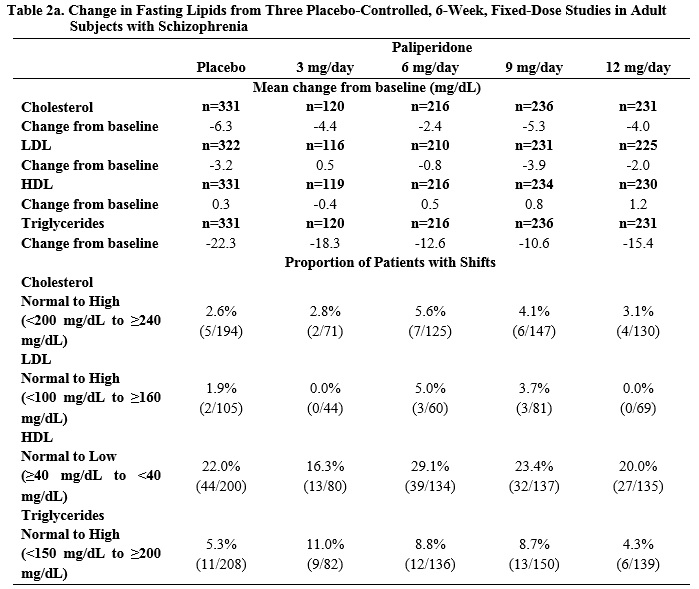
In the uncontrolled, longer-term open-label extension studies, paliperidone was associated with a mean change in (a) total cholesterol of -1.5 mg/dL at Week 24 (n=573) and -1.5 mg/dL at Week 52 (n=317), (b) triglycerides of -6.4 mg/dL at Week 24 (n=573) and -10.5 mg/dL at Week 52 (n=317); (c) LDL of -1.9 mg/dL at Week 24 (n=557) and -2.7 mg/dL at Week 52 (n=297); and (d) HDL of +2.2 mg/dL at Week 24 (n=568) and +3.6 mg/dL at Week 52 (n=302).
Data from the placebo-controlled 6-week study in adolescent subjects (12-17 years of age) with schizophrenia are presented in Table 2b.
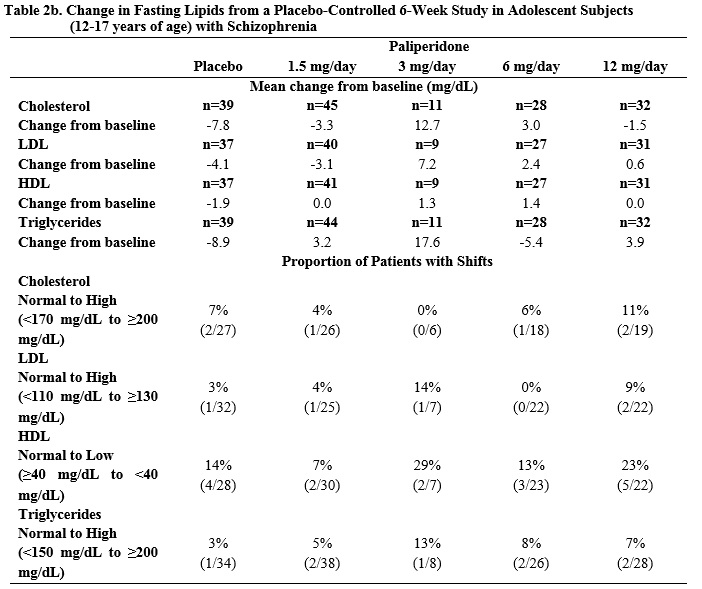
Weight Gain
Weight gain has been observed with atypical antipsychotic use. Clinical monitoring of weight is recommended.
Schizophrenia Trials
Data on mean changes in body weight and the proportion of subjects meeting a weight gain criterion of ≥ 7% of body weight from the three placebo- controlled, 6-week, fixed-dose studies in adult subjects are presented in Table 3a.

In the uncontrolled, longer-term open-label extension studies, paliperidone was associated with a mean change in weight of +1.4 kg at Week 24 (n=63) and +2.6 kg at Week 52 (n=302).
Weight gain in adolescent subjects with schizophrenia was assessed in a 6-week, double-blind, placebo-controlled study and an open-label extension with a median duration of exposure to paliperidone of 182 days. Data on mean changes in body weight and the proportion of subjects meeting a weight gain criterion of ≥ 7% of body weight [see Clinical Studies (14.1)] from the placebo-controlled 6-week study in adolescent subjects (12-17 years of age) are presented in Table 3b.

In the open-label long-term study the proportion of total subjects treated with paliperidone with an increase in body weight of ≥ 7% from baseline was 33%. When treating adolescent patients with paliperidone, weight gain should be assessed against that expected with normal growth. When taking into consideration the median duration of exposure to paliperidone in the open- label study (182 days) along with expected normal growth in this population based on age and gender, an assessment of standardized scores relative to normative data provides a more clinically relevant measure of changes in weight. The mean change from open-label baseline to endpoint in standardized score for weight was 0.1 (4% above the median for normative data). Based on comparison to the normative data, these changes are not considered to be clinically significant.
Schizoaffective Disorder Trials
In the pooled data from the two placebo-controlled, 6-week studies in adult subjects with schizoaffective disorder, a higher percentage of paliperidone- treated subjects (5%) had an increase in body weight of**≥7% compared with placebo-treated subjects (1%). In the study that examined high- and low-dose groups, the increase in body weight of≥** 7% was 3% in the low-dose group, 7% in the high-dose group, and 1% in the placebo group.
5.7 Hyperprolactinemia
Like other drugs that antagonize dopamine D2 receptors, paliperidone elevates prolactin levels and the elevation persists during chronic administration. Paliperidone has a prolactin-elevating effect similar to that seen with risperidone, a drug that is associated with higher levels of prolactin than other antipsychotic drugs.
Hyperprolactinemia, regardless of etiology, may suppress hypothalamic GnRH, resulting in reduced pituitary gonadotrophin secretion. This, in turn, may inhibit reproductive function by impairing gonadal steroidogenesis in both female and male patients. Galactorrhea, amenorrhea, gynecomastia, and impotence have been reported in patients receiving prolactin-elevating compounds. Long-standing hyperprolactinemia when associated with hypogonadism may lead to decreased bone density in both female and male subjects.
Tissue culture experiments indicate that approximately one-third of human breast cancers are prolactin dependent in vitro, a factor of potential importance if the prescription of these drugs is considered in a patient with previously detected breast cancer. An increase in the incidence of pituitary gland, mammary gland, and pancreatic islet cell neoplasia (mammary adenocarcinomas, pituitary and pancreatic adenomas) was observed in the risperidone carcinogenicity studies conducted in mice and rats [see Nonclinical Toxicology (13.1)]. Neither clinical studies nor epidemiologic studies conducted to date have shown an association between chronic administration of this class of drugs and tumorigenesis in humans, but the available evidence is too limited to be conclusive.
5.8 Potential for Gastrointestinal Obstruction
Because the paliperidone extended-release tablet is non-deformable and does not appreciably change in shape in the gastrointestinal tract, paliperidone should ordinarily not be administered to patients with pre-existing severe gastrointestinal narrowing (pathologic or iatrogenic, for example: esophageal motility disorders, small bowel inflammatory disease, “short gut” syndrome due to adhesions or decreased transit time, past history of peritonitis, cystic fibrosis, chronic intestinal pseudo-obstruction, or Meckel’s diverticulum). There have been rare reports of obstructive symptoms in patients with known strictures in association with the ingestion of drugs in non-deformable controlled-release formulations. Because of the controlled-release design of the tablet, paliperidone should only be used in patients who are able to swallow the tablet whole [see Dosage and Administration (2.3) and Patient Counseling Information (17)].
A decrease in transit time, e.g., as seen with diarrhea, would be expected to decrease bioavailability and an increase in transit time, e.g., as seen with gastrointestinal neuropathy, diabetic gastroparesis, or other causes, would be expected to increase bioavailability. These changes in bioavailability are more likely when the changes in transit time occur in the upper GI tract.
5.9 Orthostatic Hypotension and Syncope
Paliperidone can induce orthostatic hypotension and syncope in some patients because of its alpha-blocking activity. In pooled results of the three placebo-controlled, 6-week, fixed-dose trials in subjects with schizophrenia, syncope was reported in 0.8% (7/850) of subjects treated with paliperidone (3 mg, 6 mg, 9 mg, 12 mg) compared to 0.3% (1/355) of subjects treated with placebo.
Paliperidone should be used with caution in patients with known cardiovascular disease (e.g., heart failure, history of myocardial infarction or ischemia, conduction abnormalities), cerebrovascular disease, or conditions that predispose the patient to hypotension (e.g., dehydration, hypovolemia, and treatment with antihypertensive medications). Monitoring of orthostatic vital signs should be considered in patients who are vulnerable to hypotension.
5.10 Falls
Somnolence, postural hypotension, motor and sensory instability have been reported with the use of antipsychotics, including paliperidone, which may lead to falls and, consequently, fractures or other fall-related injuries. For patients, particularly the elderly, with diseases, conditions, or medications that could exacerbate these effects, assess the risk of falls when initiating antipsychotic treatment and recurrently for patients on long-term antipsychotic therapy.
5.11 Leukopenia, Neutropenia, and Agranulocytosis
In clinical trial and/or postmarketing experience, events of leukopenia/neutropenia have been reported temporally related to antipsychotic agents, including paliperidone. Agranulocytosis has also been reported.
Possible risk factors for leukopenia/neutropenia include pre-existing low white blood cell count (WBC)/absolute neutrophil count (ANC) and history of drug-induced leukopenia/neutropenia. In patients with a history of a clinically significant low WBC/ANC or a drug-induced leukopenia/neutropenia, perform a complete blood count (CBC) frequently during the first few months of therapy. In such patients, consider discontinuation of paliperidone at the first sign of a clinically significant decline in WBC in the absence of other causative factors.
Monitor patients with clinically significant neutropenia for fever or other symptoms or signs of infection and treat promptly if such symptoms or signs occur. Discontinue paliperidone in patients with severe neutropenia (absolute neutrophil count < 1000/mm3) and follow their WBC until recovery.
5.12 Potential for Cognitive and Motor Impairment
Somnolence, sedation, and dizziness were reported as adverse reactions in subjects treated with paliperidone [see Adverse Reactions (6.2)]. Antipsychotics, including paliperidone, have the potential to impair judgment, thinking, or motor skills. Patients should be cautioned about performing activities requiring mental alertness, such as operating hazardous machinery or operating a motor vehicle, until they are reasonably certain that paliperidone therapy does not adversely affect them.
5.13 Seizures
During premarketing clinical trials in subjects with schizophrenia (the three placebo-controlled, 6-week, fixed-dose studies and a study conducted in elderly schizophrenic subjects), seizures occurred in 0.22% of subjects treated with paliperidone (3 mg, 6 mg, 9 mg, 12 mg) and 0.25% of subjects treated with placebo. Like other antipsychotic drugs, paliperidone should be used cautiously in patients with a history of seizures or other conditions that potentially lower the seizure threshold. Conditions that lower the seizure threshold may be more prevalent in patients 65 years or older.
5.14 Dysphagia
Esophageal dysmotility and aspiration have been associated with antipsychotic drug use. Aspiration pneumonia is a common cause of morbidity and mortality in patients with advanced Alzheimer’s dementia. Paliperidone and other antipsychotic drugs should be used cautiously in patients at risk for aspiration pneumonia.
5.15 Priapism
Drugs with alpha-adrenergic blocking effects have been reported to induce priapism. Priapism has been reported with paliperidone during postmarketing surveillance. Severe priapism may require surgical intervention.
5.16 Body Temperature Regulation
Disruption of the body’s ability to reduce core body temperature has been attributed to antipsychotic agents. Appropriate care is advised when prescribing paliperidone to patients who will be experiencing conditions which may contribute to an elevation in core body temperature, e.g., exercising strenuously, exposure to extreme heat, receiving concomitant medication with anticholinergic activity, or being subject to dehydration.
- Cerebrovascular Adverse Reactions: An increased incidence of cerebrovascular adverse reactions (e.g. stroke, transient ischemic attack, including fatalities) has been seen in elderly patients with dementia-related psychoses treated with atypical antipsychotics. (5.2)
- Neuroleptic Malignant Syndrome: Manage with immediate discontinuation of drug and close monitoring. (5.3)
- QT Prolongation: Increase in QT interval, avoid use with drugs that also increase QT interval and in patients with risk factors for prolonged QT interval. (5.4)
- Tardive Dyskinesia: Discontinue drug if clinically appropriate. (5.5)
- Metabolic Changes: Atypical antipsychotic drugs have been associated with metabolic changes that may increase cardiovascular/cerebrovascular risk. These metabolic changes include hyperglycemia, dyslipidemia, and weight gain. (5.6)
o Hyperglycemia and Diabetes Mellitus: Monitor patients for symptoms of hyperglycemia including polydipsia, polyuria, polyphagia, and weakness. Monitor glucose regularly in patients with diabetes or at risk for diabetes. (5.6) (5)
o Dyslipidemia: Undesirable alterations have been observed in patients treated with atypical antipsychotics. (5.6) (5)
o Weight Gain: Significant weight gain has been reported. Monitor weight gain. (5.6) (5)
- Hyperprolactinemia: Prolactin elevations occur and persist during chronic administration. (5.7)
- Gastrointestinal Narrowing: Obstructive symptoms may result in patients with gastrointestinal disease. (5.8)
- Orthostatic Hypotension and Syncope: Use with caution in patients with known cardiovascular or cerebrovascular disease and patients predisposed to hypotension. (5.9)
- Leukopenia, Neutropenia, and Agranulocytosis: has been reported with antipsychotics, including paliperidone. Patients with a history of a clinically significant low white blood cell count (WBC) or a drug-induced leukopenia/neutropenia should have their complete blood count (CBC) monitored frequently during the first few months of therapy and discontinuation of paliperidone should be considered at the first sign of a clinically significant decline in WBC in the absence of other causative factors. (5.11)
- Potential for Cognitive and Motor Impairment: Use caution when operating machinery. (5.12)
- Seizures: Use cautiously in patients with a history of seizures or with conditions that lower the seizure threshold. (5.13)
ADVERSE REACTIONS SECTION
6 ADVERSE REACTIONS
The following adverse reactions are discussed in more detail in other sections of the labeling:
- Increased mortality in elderly patients with dementia-related psychosis [see Boxed Warning and Warnings and Precautions (5.1)]
- Cerebrovascular adverse reactions, including stroke, in elderly patients with dementia-related psychosis [see Warnings and Precautions (5.2)]
- Neuroleptic malignant syndrome [see Warnings and Precautions (5.3)]
- QT prolongation [see Warnings and Precautions (5.4)]
- Tardive dyskinesia [see Warnings and Precautions (5.5)]
- Metabolic changes [see Warnings and Precautions (5.6)]
- Hyperprolactinemia [see Warnings and Precautions (5.7)]
- Potential for gastrointestinal obstruction [see Warnings and Precautions (5.8)]
- Orthostatic hypotension and syncope [see Warnings and Precautions (5.9)]
- Falls [see Warnings and Precautions (5.10)]
- Leukopenia, neutropenia, and agranulocytosis [see Warnings and Precautions (5.11)]
- Potential for cognitive and motor impairment [see Warnings and Precautions (5.12)]
- Seizures [see Warnings and Precautions (5.13)]
- Dysphagia [see Warnings and Precautions (5.14)]
- Priapism [see Warnings and Precautions (5.15)]
- Disruption of body temperature regulation [see Warnings and Precautions (5.16)]
6.1 Clinical Trials Experience
The most common adverse reactions in clinical trials in adult subjects with schizophrenia (reported in 5% or more of subjects treated with paliperidone and at least twice the placebo rate in any of the dose groups) were extrapyramidal symptoms, tachycardia, and akathisia. The most common adverse reactions in clinical trials in adult patients with schizoaffective disorder (reported in 5% or more of subjects treated with paliperidone and at least twice the placebo rate) were extrapyramidal symptoms, somnolence, dyspepsia, constipation, weight increased, and nasopharyngitis.
The most common adverse reactions that were associated with discontinuation from clinical trials in adult subjects with schizophrenia (causing discontinuation in 2% of paliperidone-treated subjects) were nervous system disorders. The most common adverse reactions that were associated with discontinuation from clinical trials in adult subjects with schizoaffective disorder were gastrointestinal disorders, which resulted in discontinuation in 1% of paliperidone-treated subjects. [See Adverse Reactions (6)].
The safety of paliperidone was evaluated in 1205 adult subjects with schizophrenia who participated in three placebo-controlled, 6-week, double- blind trials, of whom 850 subjects received paliperidone at fixed doses ranging from 3 mg to 12 mg once daily. The information presented in this section was derived from pooled data from these three trials. Additional safety information from the placebo-controlled phase of the long-term maintenance study, in which subjects received paliperidone at daily doses within the range of 3 mg to 15 mg (n=104), is also included.
The safety of paliperidone was evaluated in 150 adolescent subjects 12-17 years of age with schizophrenia who received paliperidone in the dose range of 1.5 mg to 12 mg/day in a 6-week, double-blind, placebo-controlled trial.
The safety of paliperidone was also evaluated in 622 adult subjects with schizoaffective disorder who participated in two placebo-controlled, 6-week, double-blind trials. In one of these trials, 206 subjects were assigned to one of two dose levels of paliperidone: 6 mg with the option to reduce to 3 mg (n=108) or 12 mg with the option to reduce to 9 mg (n=98) once daily. In the other study, 214 subjects received flexible doses of paliperidone (3-12 mg once daily). Both studies included subjects who received paliperidone either as monotherapy or as an adjunct to mood stabilizers and/or antidepressants. Adverse events during exposure to study treatment were obtained by general inquiry and recorded by clinical investigators using their own terminology. Consequently, to provide a meaningful estimate of the proportion of individuals experiencing adverse events, events were grouped in standardized categories using MedDRA terminology.
Throughout this section, adverse reactions are reported. Adverse reactions are adverse events that were considered to be reasonably associated with the use of paliperidone (adverse drug reactions) based on the comprehensive assessment of the available adverse event information. A causal association for paliperidone often cannot be reliably established in individual cases. Further, because clinical trials are conducted under widely varying conditions, adverse reaction rates observed in the clinical trials of a drug cannot be directly compared to rates in the clinical trials of another drug and may not reflect the rates observed in clinical practice.
Commonly-Observed Adverse Reactions in Double-Blind, Placebo-Controlled Clinical Trials – Schizophrenia in Adults and Adolescents
Adult Patients with Schizophrenia
Table 4 enumerates the pooled incidences of adverse reactions reported in the three placebo-controlled, 6-week, fixed-dose studies in adults, listing those that occurred in 2% or more of subjects treated with paliperidone in any of the dose groups, and for which the incidence in paliperidone-treated subjects in any of the dose groups was greater than the incidence in subjects treated with placebo.
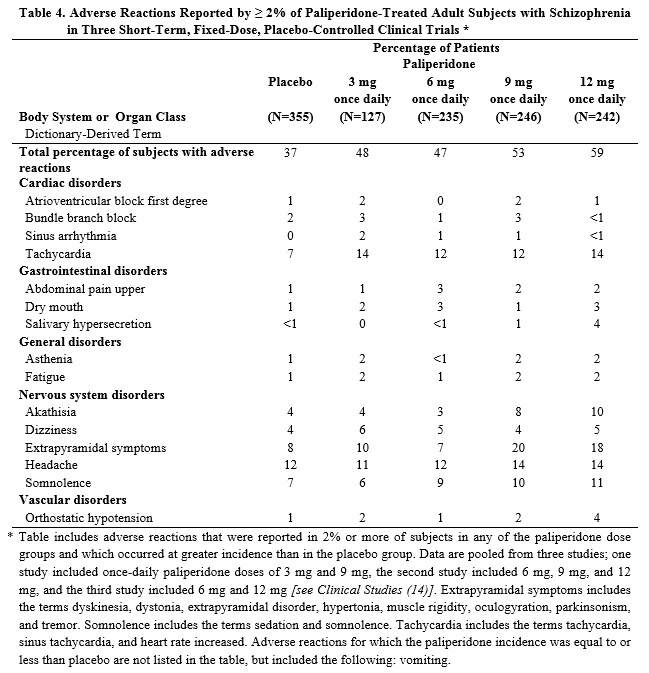
Adolescent Patients with Schizophrenia
Table 5 lists the adverse reactions reported in a fixed-dose, placebo- controlled study in adolescent subjects 12-17 years of age with schizophrenia, listing those that occurred in 2% or more of subjects treated with paliperidone in any of the dose groups, and for which the incidence in paliperidone-treated subjects in any of the dose groups was greater than the incidence in subjects treated with placebo.
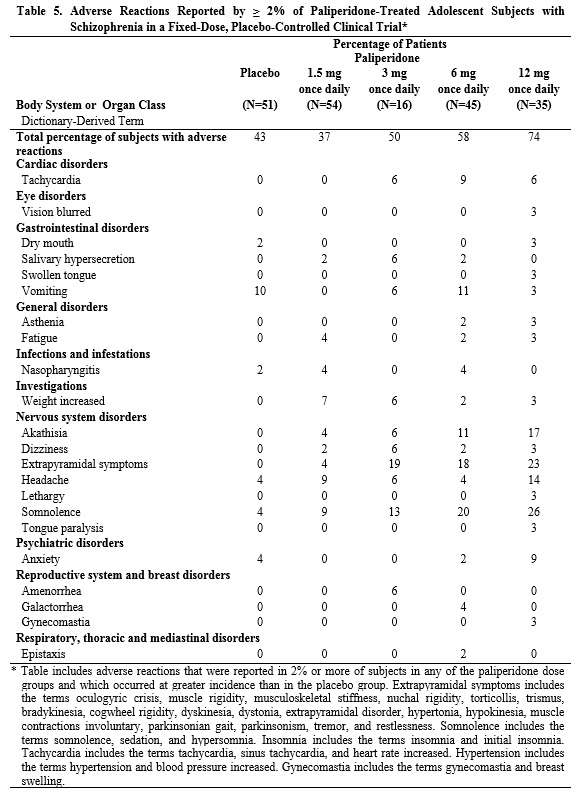
Commonly-Observed Adverse Reactions in Double-Blind, Placebo-Controlled Clinical Trials – Schizoaffective Disorder in Adults
Table 6 enumerates the pooled incidences of adverse reactions reported in the two placebo-controlled 6-week studies in adult subjects, listing those that occurred in 2% or more of subjects treated with paliperidone and for which the incidence in paliperidone-treated subjects was greater than the incidence in subjects treated with placebo.
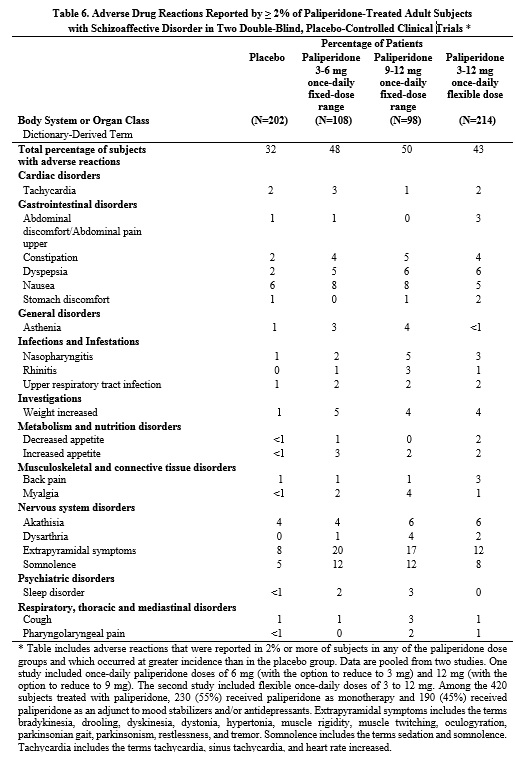
Monotherapy versus Adjunctive Therapy
The designs of the two placebo-controlled, 6-week, double-blind trials in adult subjects with schizoaffective disorder included the option for subjects to receive antidepressants (except monoamine oxidase inhibitors) and/or mood stabilizers (lithium, valproate, or lamotrigine). In the subject population evaluated for safety, 230 (55%) subjects received paliperidone as monotherapy and 190 (45%) subjects received paliperidone as an adjunct to mood stabilizers and/or antidepressants. When comparing these 2 subpopulations, only nausea occurred at a greater frequency (≥ 3% difference) in subjects receiving paliperidone as monotherapy.
Discontinuations Due to Adverse Reactions
Schizophrenia Trials
The percentages of subjects who discontinued due to adverse reactions in the three schizophrenia placebo-controlled, 6-week, fixed-dose studies in adults were 3% and 1% in paliperidone- and placebo-treated subjects, respectively. The most common reasons for discontinuation were nervous system disorders (2% and 0% in paliperidone- and placebo-treated subjects, respectively).
Among the adverse reactions in the 6-week, fixed-dose, placebo-controlled study in adolescents with schizophrenia, only dystonia led to discontinuation (<1% of paliperidone-treated subjects).
Schizoaffective Disorder Trials
The percentages of subjects who discontinued due to adverse reactions in the two schizoaffective disorder placebo-controlled 6-week studies in adults were 1% and <1% in paliperidone- and placebo-treated subjects, respectively. The most common reasons for discontinuation were gastrointestinal disorders (1% and 0% in paliperidone- and placebo-treated subjects, respectively).
Dose-Related Adverse Reactions
Schizophrenia Trials
Based on the pooled data from the three placebo-controlled, 6-week, fixed-dose studies in adult subjects with schizophrenia, among the adverse reactions that occurred with a greater than 2% incidence in the subjects treated with paliperidone, the incidences of the following adverse reactions increased with dose: somnolence, orthostatic hypotension, akathisia, dystonia, extrapyramidal disorder, hypertonia, parkinsonism, and salivary hypersecretion. For most of these, the increased incidence was seen primarily at the 12 mg dose, and, in some cases, the 9 mg dose.
In the 6-week, fixed-dose, placebo-controlled study in adolescents with schizophrenia, among the adverse reactions that occurred with >2% incidence in the subjects treated with paliperidone, the incidences of the following adverse reactions increased with dose: tachycardia, akathisia, extrapyramidal symptoms, somnolence, and headache.
Schizoaffective Disorder Trials
In a placebo-controlled, 6-week, high- and low-dose study in adult subjects with schizoaffective disorder, akathisia, dystonia, dysarthria, myalgia, nasopharyngitis, rhinitis, cough, and pharyngolaryngeal pain occurred more frequently (i.e., a difference of at least 2%) in subjects who received higher doses of paliperidone compared with subjects who received lower doses.
Demographic Differences
An examination of population subgroups in the three placebo-controlled, 6-week, fixed-dose studies in adult subjects with schizophrenia and in the two placebo-controlled, 6-week studies in adult subjects with schizoaffective disorder did not reveal any evidence of clinically relevant differences in safety on the basis of gender or race alone; there was also no difference on the basis of age [see Use in Specific Populations (8.5)].
Extrapyramidal Symptoms (EPS)
Pooled data from the three placebo-controlled, 6-week, fixed-dose studies in adult subjects with schizophrenia provided information regarding treatment- emergent EPS. Several methods were used to measure EPS: (1) the Simpson-Angus global score (mean change from baseline) which broadly evaluates Parkinsonism, (2) the Barnes Akathisia Rating Scale global clinical rating score (mean change from baseline) which evaluates akathisia, (3) use of anticholinergic medications to treat emergent EPS (Table 7), and (4) incidence of spontaneous reports of EPS (Table 8). For the Simpson-Angus Scale, spontaneous EPS reports and use of anticholinergic medications, there was a dose-related increase observed for the 9 mg and 12 mg doses. There was no difference observed between placebo and paliperidone 3 mg and 6 mg doses for any of these EPS measures.
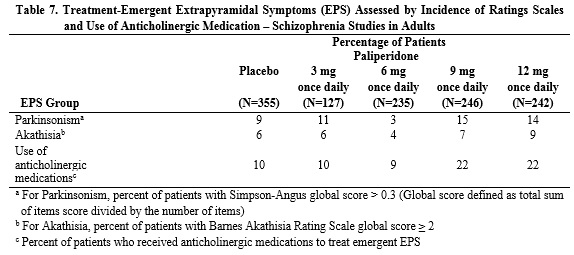
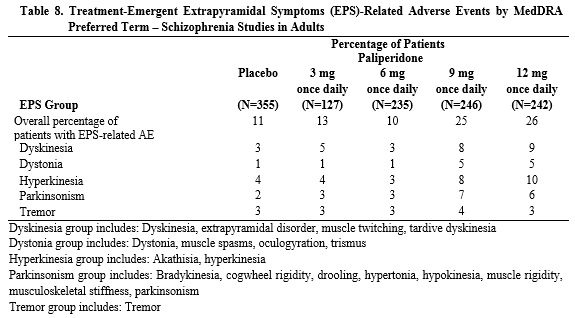
Compared to data from the studies in adults subjects with schizophrenia, pooled data from the two placebo-controlled 6-week studies in adult subjects with schizoaffective disorder showed similar types and frequencies of EPS as measured by rating scales, anticholinergic medication use, and spontaneous reports of EPS-related adverse events. For subjects with schizoaffective disorder, there was no dose-related increase in EPS observed for parkinsonism with the Simpson-Angus scale or akathisia with the Barnes Akathisia Rating Scale. There was a dose-related increase observed with spontaneous EPS reports of hyperkinesia and dystonia and in the use of anticholinergic medications.
Table 9 shows the EPS data from the pooled schizoaffective disorder trials.
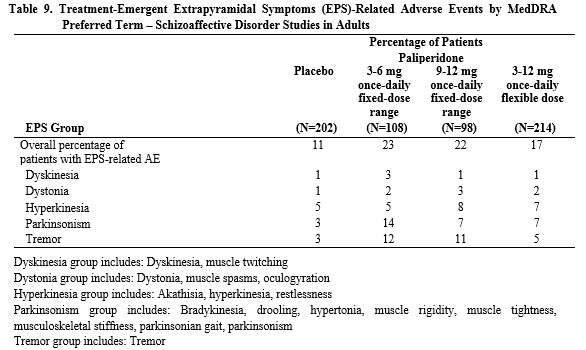
The incidences of EPS-related adverse events in the adolescent schizophrenia studies showed a similar dose-related pattern to those in the adult studies. There were notably higher incidences of dystonia, hyperkinesia, tremor, and parkinsonism in the adolescent population as compared to the adult studies (Table 10).
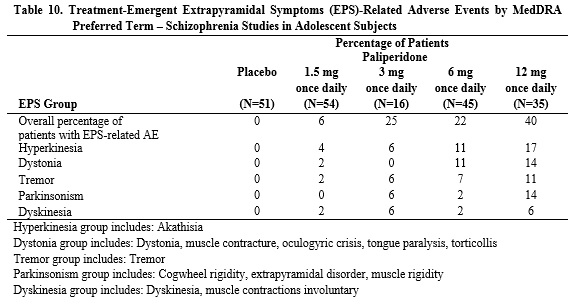
Dystonia
Class Effect: Symptoms of dystonia, prolonged abnormal contractions of muscle groups, may occur in susceptible individuals during the first few days of treatment. Dystonic symptoms include: spasm of the neck muscles, sometimes progressing to tightness of the throat, swallowing difficulty, difficulty breathing, and/or protrusion of the tongue. While these symptoms can occur at low doses, they occur more frequently and with greater severity with high potency and at higher doses of first generation antipsychotic drugs. An elevated risk of acute dystonia is observed in males and younger age groups.
Laboratory Test Abnormalities
In the pooled data from the three placebo-controlled, 6-week, fixed-dose studies in adult subjects with schizophrenia and from the two placebo- controlled, 6-week studies in adult subjects with schizoaffective disorder, between-group comparisons revealed no medically important differences between paliperidone and placebo in the proportions of subjects experiencing potentially clinically significant changes in routine serum chemistry, hematology, or urinalysis parameters. Similarly, there were no differences between paliperidone and placebo in the incidence of discontinuations due to changes in hematology, urinalysis, or serum chemistry, including mean changes from baseline in fasting glucose, insulin, c-peptide, triglyceride, HDL, LDL, and total cholesterol measurements. However, paliperidone was associated with increases in serum prolactin [see Warnings and Precautions (5.7)].
Other Adverse Reactions Observed During Premarketing Evaluation of Paliperidone
The following additional adverse reactions occurred in < 2% of paliperidone- treated subjects in the above schizophrenia and schizoaffective disorder clinical trial datasets. The following also includes additional adverse reactions reported at any frequency by paliperidone-treated subjects who participated in other clinical studies.
**Cardiac disorders:**bradycardia, palpitations
**Eye disorders:**eye movement disorder
**Gastrointestinal disorders:**flatulence
**General disorders:**edema
**Immune system disorders:**anaphylactic reaction
**Infections and infestations:**urinary tract infection
**Investigations:**alanine aminotransferase increased, aspartate aminotransferase increased
**Musculoskeletal and connective tissue disorders:**arthralgia, pain in extremity
**Nervous system disorders:**opisthotonus
**Psychiatric disorders:**agitation, insomnia, nightmare
**Reproductive system and breast disorders:**breast discomfort, menstruation irregular, retrograde ejaculation
**Respiratory, thoracic and mediastinal disorders:**nasal congestion
**Skin and subcutaneous tissue disorders:**pruritus, rash
**Vascular disorders:**hypertension
The safety of paliperidone was also evaluated in a long-term trial designed to assess the maintenance of effect with paliperidone in adults with schizophrenia [see Clinical Studies (14)]. In general, adverse reaction types, frequencies, and severities during the initial 14-week open-label phase of this study were comparable to those observed in the 6-week, placebo- controlled, fixed-dose studies. Adverse reactions reported during the long- term double-blind phase of this study were similar in type and severity to those observed in the initial 14-week open-label phase.
6.2 Postmarketing Experience
The following adverse reactions have been identified during postapproval use of paliperidone; because these reactions were reported voluntarily from a population of uncertain size, it is not possible to reliably estimate their frequency: angioedema, catatonia, ileus, priapism, somnambulism, swollen tongue, tardive dyskinesia, thrombotic thrombocytopenic purpura, urinary incontinence, urinary retention.
6.3 Adverse Reactions Reported with Risperidone
Paliperidone is the major active metabolite of risperidone. Adverse reactions reported with risperidone can be found in the ADVERSE REACTIONS section of the risperidone package insert.
Commonly observed adverse reactions (incidence ≥ 5% and at least twice that for placebo) were (6) (6)
- Adults with schizophrenia: extrapyramidal symptoms, tachycardia, and akathisia.
- Adolescents with schizophrenia: somnolence, akathisia, tremor, dystonia, cogwheel rigidity, anxiety, weight increased, and tachycardia.
- Adults with schizoaffective disorder: extrapyramidal symptoms, somnolence, dyspepsia, constipation, weight increased, and nasopharyngitis.
To report SUSPECTED ADVERSE REACTIONS, contact Ascent Pharmaceuticals, Inc., at 1-855-221-1622 or FDA at 1-800-FDA-1088 or****www.fda.gov/medwatch (6)
DOSAGE & ADMINISTRATION SECTION
2 DOSAGE AND ADMINISTRATION
2.1 Schizophrenia
Adults
The recommended dose of paliperidone extended-release tablets for the treatment of schizophrenia in adults is 6 mg administered once daily. Initial dose titration is not required. Although it has not been systematically established that doses above 6 mg have additional benefit, there was a general trend for greater effects with higher doses. This must be weighed against the dose-related increase in adverse reactions. Thus, some patients may benefit from higher doses, up to 12 mg/day, and for some patients, a lower dose of 3 mg/day may be sufficient. Dose increases above 6 mg/day should be made only after clinical reassessment and generally should occur at intervals of more than 5 days. When dose increases are indicated, increments of 3 mg/day are recommended. The maximum recommended dose is 12 mg/day.
In a longer-term study, paliperidone extended-release tablets have been shown to be effective in delaying time to relapse in patients with schizophrenia who were stabilized on paliperidone extended-release tablets for 6 weeks [see Clinical Studies (14)]. Paliperidone extended-release tablets should be prescribed at the lowest effective dose for maintaining clinical stability and the physician should periodically reevaluate the long-term usefulness of the drug in individual patients.
Adolescents (12-17 years of age)
The recommended starting dose of paliperidone extended-release tablets for the treatment of schizophrenia in adolescents 12-17 years of age is 3 mg administered once daily. Initial dose titration is not required. Dose increases, if considered necessary, should be made only after clinical reassessment and should occur at increments of 3 mg/day at intervals of more than 5 days. Prescribers should be mindful that, in the adolescent schizophrenia study, there was no clear enhancement to efficacy at the higher doses, i.e., 6 mg for subjects weighing less than 51 kg and 12 mg for subjects weighing 51 kg or greater, while adverse events were dose-related.
2.2 Schizoaffective Disorder
The recommended dose of paliperidone extended-release tablets for the treatment of schizoaffective disorder in adults is 6 mg administered once daily. Initial dose titration is not required. Some patients may benefit from lower or higher doses within the recommended dose range of 3 to 12 mg once daily. A general trend for greater effects was seen with higher doses. This trend must be weighed against dose-related increase in adverse reactions. Dosage adjustment, if indicated, should occur only after clinical reassessment. Dose increases, if indicated, generally should occur at intervals of more than 4 days. When dose increases are indicated, increments of 3 mg/day are recommended. The maximum recommended dose is 12 mg/day.
2.3 Administration Instructions
Paliperidone extended-release tablets can be taken with or without food.
Paliperidone extended-release tablets must be swallowed whole with the aid of liquids. Tablets should not be chewed, divided, or crushed. The medication is contained within a nonabsorbable shell designed to release the drug at a controlled rate. The tablet shell, along with insoluble core components, is eliminated from the body; patients should not be concerned if they occasionally notice in their stool something that looks like a tablet.
2.4 Use with Risperidone
Concomitant use of paliperidone extended-release tablets with risperidone has not been studied. Since paliperidone is the major active metabolite of risperidone, consideration should be given to the additive paliperidone exposure if risperidone is coadministered with paliperidone extended-release tablets.
2.5 Dosage in Special Populations
Renal Impairment
Dosing must be individualized according to the patient’s renal function status. For patients with mild renal impairment (creatinine clearance ≥ 50 mL/min to < 80 mL/min), the recommended initial dose of paliperidone extended- release tablets is 3 mg once daily. The dose may then be increased to a maximum of 6 mg once daily based on clinical response and tolerability. For patients with moderate to severe renal impairment (creatinine clearance ≥ 10 mL/min to < 50 mL/min), the recommended initial dose of paliperidone extended- release tablets is 1.5 mg once daily, which may be increased to a maximum of 3 mg once daily after clinical reassessment. As paliperidone extended-release tablets have not been studied in patients with creatinine clearance below 10 mL/min, use is not recommended in such patients. [See Clinical Pharmacology (12.3)]
Hepatic Impairment
For patients with mild to moderate hepatic impairment, (Child-Pugh Classification A and B), no dose adjustment is recommended [see Clinical Pharmacology (12.3)]. Paliperidone extended-release tablets have not been studied in patients with severe hepatic impairment.
Elderly
Because elderly patients may have diminished renal function, dose adjustments may be required according to their renal function status. In general, recommended dosing for elderly patients with normal renal function is the same as for younger adult patients with normal renal function. For patients with moderate to severe renal impairment (creatinine clearance 10 mL/min to < 50 mL/min), the maximum recommended dose of paliperidone extended-release tablets are 3 mg once daily [see Renal Impairment above].
|
(2) |
Initial Dose (2) |
Recommended Dose (2) |
Maximum Dose (2) | |
|
Schizophrenia - adults (2.1) (2) |
6 mg/day (2) |
3 - 12 mg/day (2) |
12 mg/day (2) | |
|
Schizophrenia-adolescents (2.1) (2) |
Weight (2) < 51kg (2) |
3 mg/day (2) |
3 - 6 mg/day (2) |
6 mg/day (2) |
|
Weight (2) ≥ 51kg (2) |
3 mg/day (2) |
3 - 12 mg/day (2) |
12 mg/day (2) | |
|
Schizoaffective disorder - (2) adults (2.2) (2) |
6 mg/day (2) |
3 - 12 mg/day (2) |
12 mg/day (2) |
- Tablet should be swallowed whole and should not be chewed, divided, or crushed. (2.3)
DRUG ABUSE AND DEPENDENCE SECTION
9 DRUG ABUSE AND DEPENDENCE
9.1 Controlled Substance
Paliperidone is not a controlled substance.
9.2 Abuse
Paliperidone has not been systematically studied in animals or humans for its potential for abuse. It is not possible to predict the extent to which a CNS- active drug will be misused, diverted, and/or abused once marketed. Consequently, patients should be evaluated carefully for a history of drug abuse, and such patients should be observed closely for signs of paliperidone misuse or abuse (e.g., development of tolerance, increases in dose, drug- seeking behavior)
9.3 Dependence
Paliperidone has not been systematically studied in animals or humans for its potential for tolerance or physical dependence.
NONCLINICAL TOXICOLOGY SECTION
13 NONCLINICAL TOXICOLOGY
13.1 Carcinogenesis, Mutagenesis, Impairment of Fertility
Carcinogenesis
Carcinogenicity studies with paliperidone administered orally have not been performed.
Carcinogenicity studies with risperidone, which is extensively converted to paliperidone in rats, mice, and humans, were conducted in Swiss albino mice and Wistar rats. Risperidone was administered in the diet at daily doses of 0.63, 2.5, and 10 mg/kg for 18 months to mice and for 25 months to rats. A maximum tolerated dose was not achieved in male mice. There were statistically significant increases in pituitary gland adenomas, endocrine pancreas adenomas, and mammary gland adenocarcinomas. The no-effect dose for these tumors was less than or equal to the MRHD of risperidone based on mg/m2 body surface area (see risperidone package insert). An increase in mammary, pituitary, and endocrine pancreas neoplasms has been found in rodents after chronic administration of other antipsychotic drugs and is considered to be mediated by prolonged dopamine D2 antagonism and hyperprolactinemia. The relevance of these tumor findings in rodents to human risk is unclear [see Warnings and Precautions (5.7)].
Mutagenesis
No evidence of genotoxic potential for paliperidone was found in the Ames reverse mutation test, the mouse lymphoma assay, or the in vivo rat micronucleus test.
Impairment of Fertility
In a study of fertility, the percentage of treated female rats that became pregnant was not affected at oral doses of paliperidone of up to 2.5 mg/kg/day which is 2 times the MRHD based on mg/m2 body surface area. However, pre- and post-implantation loss was increased, and the number of live embryos was slightly decreased, at 2.5 mg/kg, a dose that also caused slight maternal toxicity. These parameters were not affected at a dose of 0.63 mg/kg, which is half of the MRHD based on mg/m2 body surface area.
The fertility of male rats was not affected at oral doses of paliperidone of up to 2 times the MRHD of 12 mg/day based on mg/m2 body surface area, although sperm count and sperm viability studies were not conducted with paliperidone. In a subchronic study in Beagle dogs with risperidone, which is extensively converted to paliperidone in dogs and humans, all doses tested (0.31 mg/kg - 5.0 mg/kg) resulted in decreases in serum testosterone and in sperm motility and concentration (0.6 to 10 times the MRHD of 16 mg/day for risperidone, based on mg/m2 body surface area). Serum testosterone and sperm parameters partially recovered, but remained decreased after the last observation (two months after treatment was discontinued).
INFORMATION FOR PATIENTS SECTION
17 PATIENT COUNSELING INFORMATION
Physicians are advised to discuss the following issues with patients for whom they prescribe paliperidone.
Neuroleptic Malignant Syndrome (NMS)
Counsel patients about a potentially fatal adverse reaction, Neuroleptic Malignant Syndrome (NMS), that has been reported in association with administration of antipsychotic drugs. Advise patients, family members, or caregivers to contact their healthcare provider or report to the emergency room if they experience signs and symptoms of NMS, including hyperpyrexia, muscle rigidity, altered mental status including delirium, and evidence of autonomic instability (irregular pulse or blood pressure, tachycardia, diaphoresis, and cardiac dysrhythmia) [see Warnings and Precautions (5.3)].
Tardive Dyskinesia
Counsel patients on the signs and symptoms of tardive dyskinesia and to contact their healthcare provider if these abnormal movements occur [see Warnings and Precautions (5.5)].
Metabolic Changes
Educate patients about the risk of metabolic changes, how to recognize symptoms of hyperglycemia and diabetes mellitus, and the need for specific monitoring, including blood glucose, lipids, and weight [see Warnings and Precautions (5.6)].
Orthostatic Hypotension
Educate patients about the risk of orthostatic hypotension and syncope, particularly at the time of initiating treatment, re-initiating treatment, or increasing the dose [see Warnings and Precautions (5.9)].
Leukopenia/Neutropenia
Advise patients with a pre-existing low WBC or a history of drug-induced leukopenia/neutropenia they should have their CBC monitored while taking paliperidone [see Warnings and Precautions (5.11)].
Hyperprolactinemia
Counsel patients on signs and symptoms of hyperprolactinemia that may be associated with chronic use of paliperidone. Advise them to seek medical attention if they experience any of the following: amenorrhea or galactorrhea in females, erectile dysfunction or gynecomastia in males [see Warnings and Precautions (5.7)].
Interference with Cognitive and Motor Performance
Caution patients about performing activities requiring mental alertness, such as operating hazardous machinery, or operating a motor vehicle, until they are reasonably certain that paliperidone therapy does not affect them adversely [see Warnings and Precautions (5.12)].
Priapism
Advise patients of the possibility of painful or prolonged penile erections (priapism). Instruct the patient to seek immediate medical attention in the event of priapism [see Warnings and Precautions (5.15)].
Heat Exposure and Dehydration
Counsel patients on the importance of avoiding overheating and dehydration [see Warnings and Precautions (5.16)].
Concomitant Medication
Advise patients to inform their healthcare providers if they are taking, or plan to take, any prescription or over-the-counter drugs, as there is a potential for interactions [see Drug Interactions (7)].
Alcohol
Advise patients to avoid alcohol while taking paliperidone [see Drug Interactions (7.1)].
Administration
Patients should be informed that paliperidone extended-release tablets should be swallowed whole with the aid of liquids. Tablets should not be chewed, divided, or crushed. The medication is contained within a nonabsorbable shell designed to release the drug at a controlled rate. The tablet shell, along with insoluble core components, is eliminated from the body; patients should not be concerned if they occasionally notice something that looks like a tablet in their stool [see Dosage and Administration (2.3)].
Pregnancy
Advise patients to notify their healthcare provider if they become pregnant or intend to become pregnant during treatment with paliperidone. Advise patients that paliperidone may cause extrapyramidal and/or withdrawal symptoms in a neonate. Advise patients that there is a pregnancy registry that monitors pregnancy outcomes in women exposed to paliperidone during pregnancy [see Use in Specific Populations (8.1)].
Lactation
Advise breastfeeding women using paliperidone to monitor infants for somnolence, failure to thrive, jitteriness, and extrapyramidal symptoms (tremors and abnormal muscle movements) and to seek medical care if they notice these signs [see Use in Specific Populations (8.2)].
Infertility
Advise females of reproductive potential that paliperidone may impair fertility due to an increase in serum prolactin levels. The effects on fertility are reversible [see Use in Specific Populations (8.3)].
All Product/Brand names are the trademarks of their respective owners.
Manufactured by:
Ascent Pharmaceuticals, Inc.
Central Islip, NY 11722
Rev: 08/23
